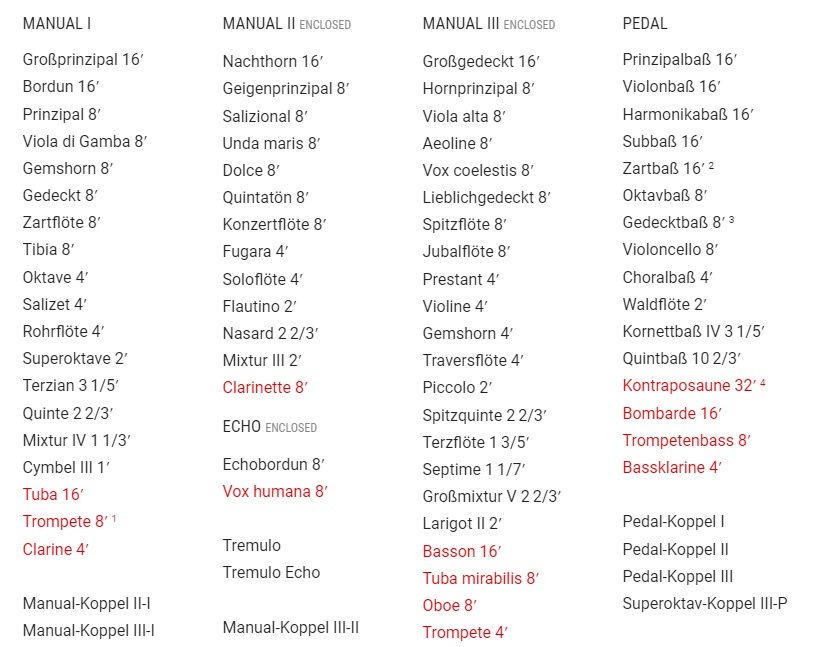Orgel Samplesets von Piotr Grabowski
Inzwischen ist Piotr in der Branche als Qualitätshersteller von hervorragenden Orgelsamples für Grande Orque und Hauptwerk bekannt.
Ab sofort erhalten sie die Downloads auch über uns . Wir hoffen sie machen regen Gebrauch davon.
Ihr Oliver Schmidt
Schuke Orgel Prediger Kirche Erfurt

Erhältlich ab 5. November 2022
| HAUPTWERKPrincipal 16′ Principal 8′ Koppelflöte 8′ Viola di Gamba 8′ Quinte 5 1/3′ Oktave 4′ Gemshorn 4′ Quinte 2 2/3′ Oktave 2′ Groß-Mixtur 6f. Klein-Mixtur 4f. Trompete 16′ Trompete 8′ II / I III / I |
SCHWELLWERK Gedackt 16′ Principal 8′ Holzflöte 8′ Spitzgedackt 8′ Salicional 8′ Oktave 4′ Nachthorn 4′ Rohrnassat 2 2/3′ Waldflöte 2′ Terz 1 3/5′ Spitzquinte 1 1/3′ Sifflöte 1′ Oberton 2f. Mixtur 5f. Cymbel 3f. Dulcian 16′ Oboe 8′ Tremulant |
POSITIVGedackt 8′ Quintadena 8′ Principal 4′ Rohrflöte 4′ Sesquialtera 2f. Oktave 2′ Spitzflöte 2′ Quinte 1 1/3′ Scharff 5 f. Spillregal 16′ Trichterregal 8′ Tremulant |
PEDALPrincipal 16′
Downloadpreis € 423,- |
Ermelo is a town located in the province Gelderland in The Netherlands. The Emmanuel Church (Immanuelkerk) was built in 1899 and later expanded with a tower in 1921-1922. It hosts a magnificent organ, built by famous Dutch organbuilder Reil in 1981. Its conception was heavily based on the organ of the Hervormde Kerk in Tzum, which was built by 1763-1764 by Albertus Anthoni Hinsz.
The stoplist of the organ of Ermelo is almost the same as its Tzum counterpart, with the exception of the pedal division. The original organ pedal keyboard has no stops, so it only couples manuals. In Ermelo, the pedal division was created with 5 stops assigned to it. Klaas Bolt, a well-known Dutch organist, was the advisor for the organ building project.
The sample set introduced a few small changes. The original tremulant affects the whole organ, however this behaviour can be changed in the Simple Jamb tab and chosen divisions can be disabled from the tremulant. One coupler was added (Rugwerk / Pedaal) and it is also available from the Simple Jamb tab. The keyboard compasses were slightly extended: the manuals from the C-f3 to C-a3 and the pedal from C-d1 to C-f1.
|
HOOFDWERKBourdon 16 voet Manual koppel |
RUGWERKHolpijp 8 voet Praestant 4 voet Roerfluit 4 voet Octaaf 2 voet Gemshoorn 2 voet Sesquialter II sterk Dulciaan 8 voet |
PEDAALSubbas 16 voet Pedal koppel |
||||||||||||||||||||||||||||||||||||||||||||||||||||||||||||||||||||||||||||||||||||||||||||||||
|
Tremulant Download Preis € 210,- |
||||||||||||||||||||||||||||||||||||||||||||||||||||||||||||||||||||||||||||||||||||||||||||||||||

Nitra, Katedrála sv. Emeráma, Slovakia
Nitra is a city in the western part of Slovakia, situated by the river with the same name. The St. Emmeram’s Cathedral (Katedrála sv. Emeráma) is a part of the buildings of the Nitra castle. It is picturesquely situated on a hill surrounded by the river. The cathedral has mostly a baroque look now, however its history is much older, goes back to the medieval times.
The baroque organ in the cathedral was built in 1718-1723 by Martin Zorkovský. It is not known if it was 1 or 2 manual organ at time. The section of Rückpositiv was added later, probably in the end of the 18th century. The instrument was rebuilt in the 1870s by Martin Šaško and later completely modified by Otokár Vážanský in 1932. It became a romantic organ with tubular action – completely unlike the original. Almost one century later, in the years 2016-2017 a new organ was built by Austrian company Kögler. It is now pure baroque style. Around 200 of the old baroque pipes were used, mainly prospect pipes. The Rückpositiv case was made new to better fit a larger organ case. The new organ is very versatile, full of colorful stops, which fits perfectly with the acoustics of the Nitra cathedral.
Manual compass is from C to g3, pedal from C to f1. The organ is originally tuned to Neidhardt “Grosse Stadt” (big city) temperament, which was included with the sample set.
Nitra, Katedrála sv. Emeráma, Slovakia
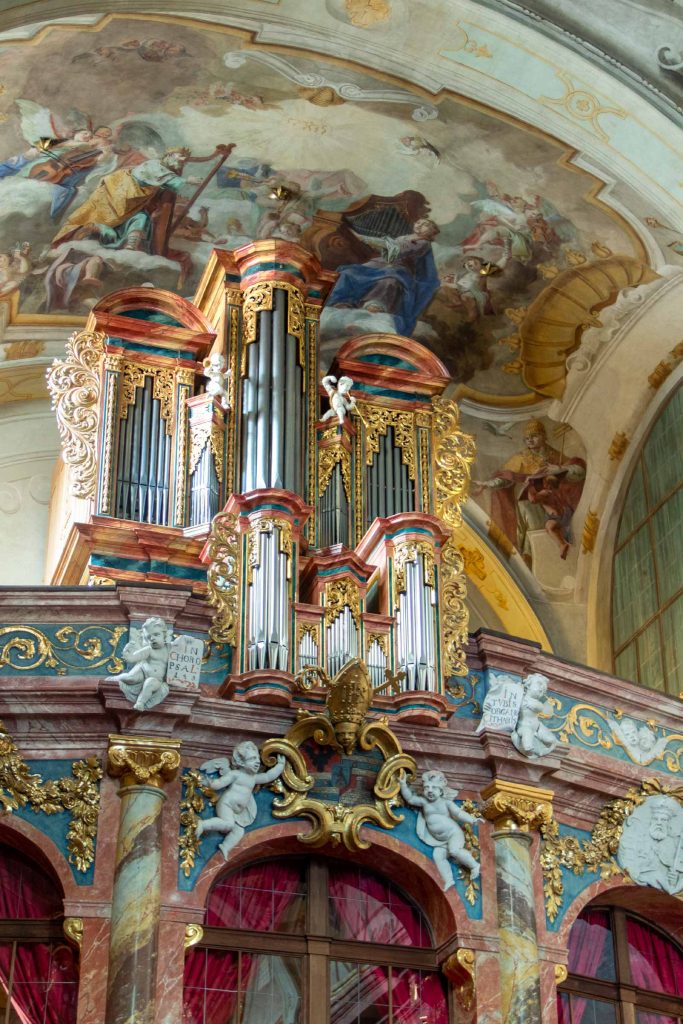
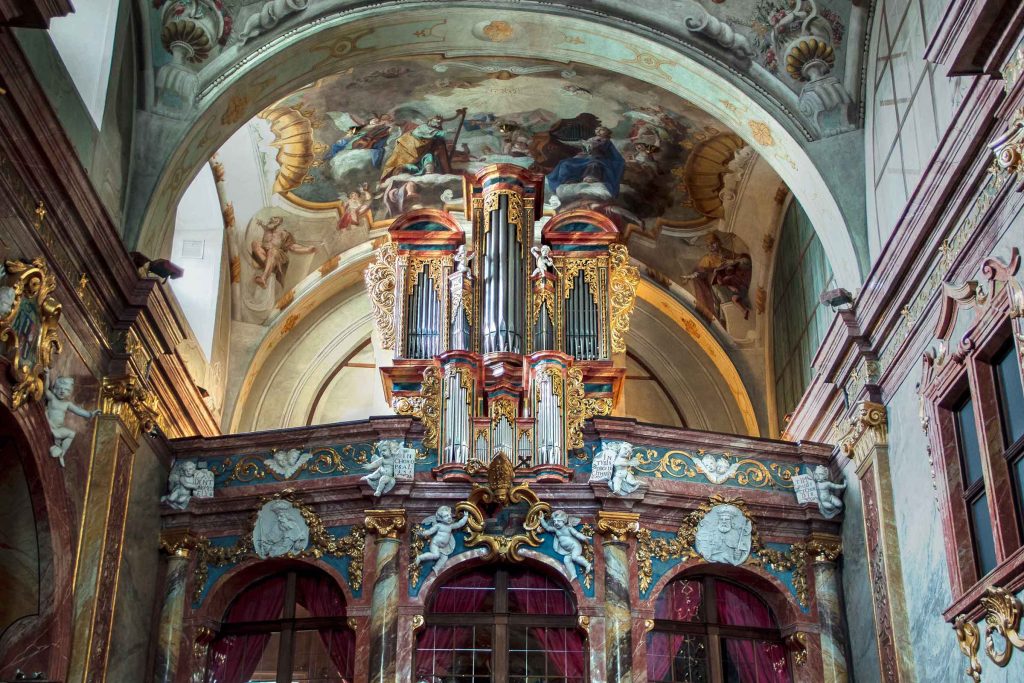
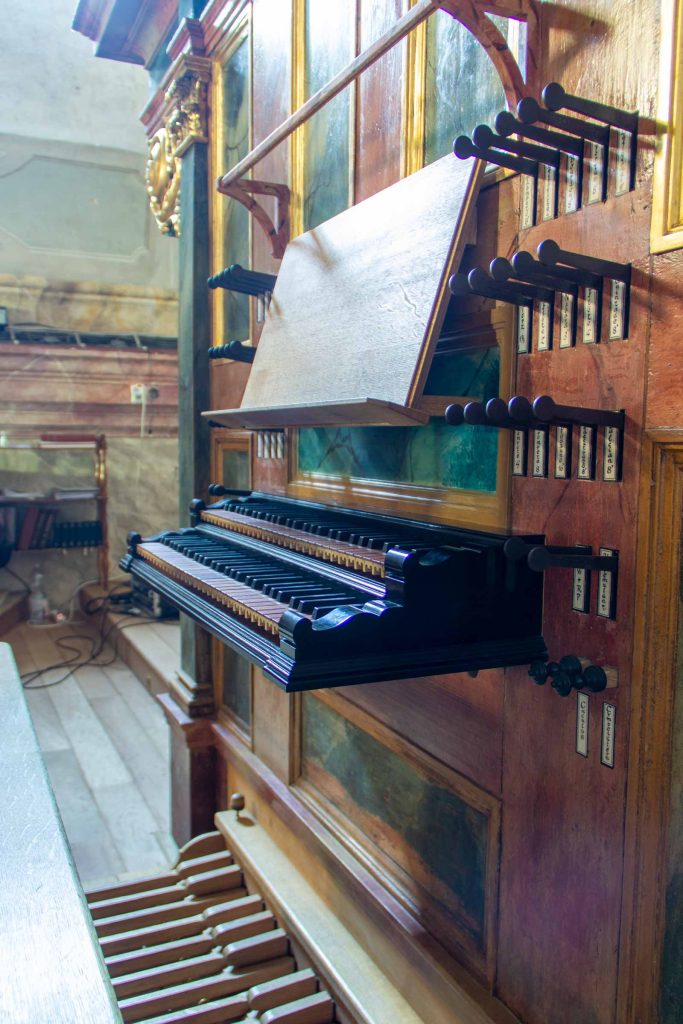
| RÜCKPOSITIVCopula maior 8′ Quintade 8′ Principal 4′ Flöte 4′ Nasard 3′ Octave 2′ Flöte 2′ Terz 1 3/5′ Quinte 1 1/3′ Octave 1′ Mixtur III-IV Dulcian 8′ Tremulant |
HAUPTWERKBourdon 16′ Principal 8′ Bourdon 8′ Salicional 8′ Portun 8′ Octave 4′ Spitzflöte 4′ Quint 3′ Superoctave 2′ Mixtur IV-VI Trompete 8′ HW + RP |
PEDALSubbass 16′ Octavbass 8′ Gedecktbass 8′ Octave 4′ Posaune 16′ Trompete 8′ Trompete 4′ Ped + RP Ped + HW |
Technical details
| General | |
|---|---|
| Sample rate | 48 kHz |
| Bit resolution | 24 bit |
| Channel count | 6 (3 × Stereo) |
| Tremulant model | sampled chromatically |
| Compatible software | Hauptwerk v. 4.2 or higher |
| Memory requirements | |
| 24 bit, 6 channels | 28 GB |
| 16 bit, 6 channels | 14 GB |
| 24 bit, 2 channels | 10.0 GB |
| 16 bit, 2 channels | 5.0 GB |
Download Preis. € 220,-
Święta Lipka, Sanktuarium Nawiedzenia Najświętszej Maryi Panny, Poland
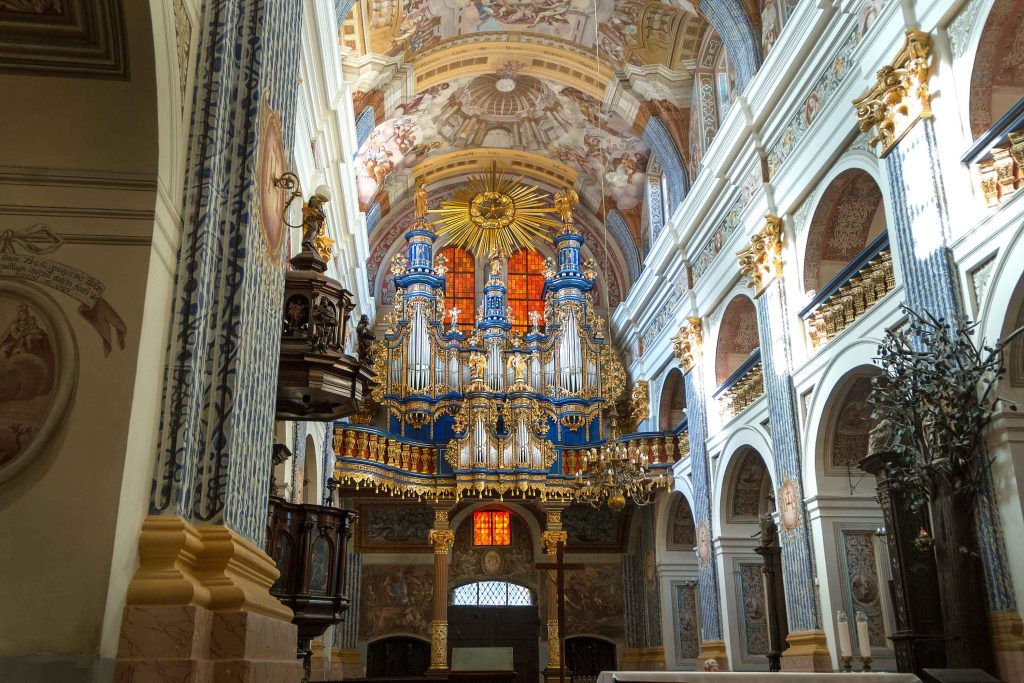
Święta Lipka Audio Player
(ger. Heiligelinde) is a village in North-West Poland in Masurian Lake District. The agreement for the first organ for the sanctuary in Święta Lipka was signed in 1719. The construction was commissioned to Johann Josua Mosengel. It had 21 stops spread over 2 manuals with no pedalboard. During the construction work it was decided to extend the organ with an additional positiv division and later a pedal division resulting in 1721 with 3 manuals with pedals accumulating to 40 stops.
In 1905 Bruno Goebel was commissioned to do a general overhaul, but what transpired was a new instrument in the old baroque organ case. Old windchests were removed and new tubular key and stop action was applied. The stoplist was reduced to 2 manuals with pedal and followed the then romantic trend. Only 3 stops from the original organ remained: Principal 16′ and Octave 8′ from the pedal and Grossgedeckt 16′ from the 1st manual. In 1945 all of the metal pipework was destroyed by soldiers of the Soviet Red Army. Most of the missing pipework was replaced in the years 1965-1973. Reed pipes were made by the company of Ernest Pękała in the 1970s. The only original reed stop in the organ is the Fagotto 16′ from the 1st manual division. It is a free reed stop which is quite unusual. It is worth mentioning the religious brother Waldemar Strzyżewski who became an organist in Święta Lipka in 1965 as he was also an organ builder who continuously repaired the organ over many years. In the 70s he installed an electric driving gear for the figures, by which point hadn’t been moving for over 150 years.
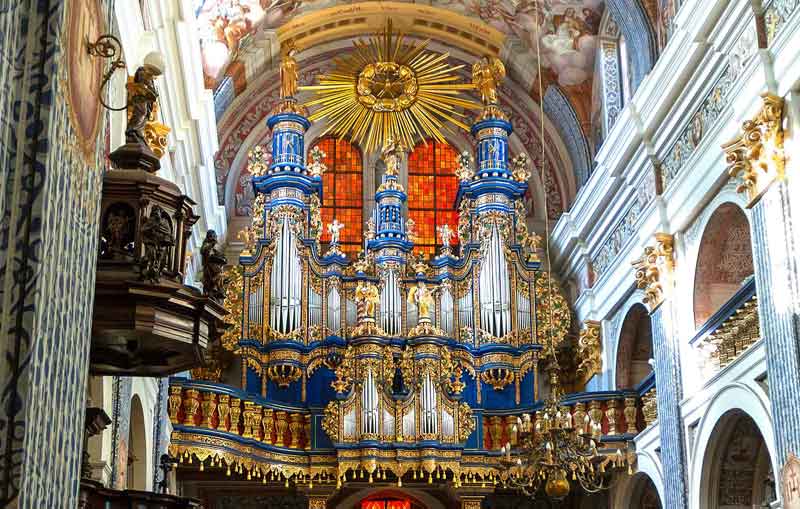
| MANUAL IGrossgedeckt 16′ Principal 8′ Gemshorn 8′ Schalmei 8′ Salicional 8′ Labial Klarinette 8′ Rohrflöte 8′ Octave 4′ Flöte 4′ Piccolo 2′ Rauschquinte 2 2/3′ 2 fach Mixtur 3-4 fach Cornett 4 fach Zimbel 3 fach Trompete 16′ Fagotto 16′ Trompete 8′ Krumhorn 8′ Glockenspiel Manual Coppel II. zu I.M. Suboctavcoppel II. zu I.M. Superoctavcoppel |
MANUAL II Bordun 16′ Principal amabile 8′ Viola di Gamba 8′ Flauto amabile 8′ Quintadena 8′ Gedackt 8′ Unda maris 8′ Aeoline 8′ Prestant 4′ Terz 1 3/5′ Progressiv 4 fach Trompete 8′ zu II.M. Superoctavcoppel |
PEDALPrincipal 16′ Violon 16′ Salicet 16′ Subbas 16′ Nasard 10 2/3′ Octave 8′ Cello 8′ Gedacktbass 8′ Superoctave 4′ Posaune 16′ Fagotto 16′ 1 extension Trompete 8′ extension zu I.M. Pedalcoppel zu II.M. Pedalcoppel |
||||||||||||||||||||||||||||||||||||||||||||||||||||||||||||||||||||||||||||||||||||||||||||||||||||||||||||||||||||||||||||||
|
Tremulant
Technical details
Downloadpreis € 279,- |
||||||||||||||||||||||||||||||||||||||||||||||||||||||||||||||||||||||||||||||||||||||||||||||||||||||||||||||||||||||||||||||||
Nancy, Cathédrale Notre-Dame-de-l'Annonciation, France

The history of the organ starts in 1763 when Nicolas Dupont built the first instrument in the newly built cathedral which was at the time Dupont’s largest organ with 44 stops. The 16′ facade was a remarkable feat for its time. The construction took Dupont 8 years and he retained care of the instrument until his death in 1781.
After Dupont’s death, Jean-François Vautrin took care of the instrument who added a stop grosse caisse (bass drum), as well as other repairs in 1788. As the French revolution started in 1789 the organ incredibly didn’t suffer any loss, largely thanks to its then organist – Michelot. More restoration work and enlargements were needed in 1808, including a keyboard extension from d3 to f3, 4 new additional stops to the Swell, and several stops were modified to the Grand Orgue and Positif divisions. Another important extension was made with the addition of two Bombarde stops (16′ and 32′). It’s worth noting it was the first Bombarde 32′ stop ever built in France.
| POSITIFMontre 8 Bourdon 8 Prestant 4 Nasard 2 2/3 Doublette 2 1 Tierce 1 3/5 Larigot 1 1/3 Piccolo 1 1 Cornet 5 rgs Fourniture 4 rgs 1 Trompette 8 1 Cromorne 8 1 Basson et Hautbois 8 1 Clairon 4 1 IV / I extension |
GRAND-ORGUEMontre 16 Bourdon 16 Montre 8 Bourdon 8 Flûte harmonique 8 Prestant 4 Flûte douce 4 Tierce 3 1/5 Quinte 2 2/3 Doublette 2 Septième 1 1/7 I / II III / II IV / II Octaves graves 2 extension |
BOMBARDEPrincipal 8 1 Principal 4 1 Principal 2 1 Cornet 5 rgs 1 Fourniture 5 rgs 1 Cymbale 4 rgs 1 Bombarde 16 1 1ère Trompette 8 1 2ème Trompette 8 1 Cromorne 8 1 Clairon 4 1 |
RÉCIT EXPRESSIFQuintaton 16 Principal 8 1 Bourdon 8 1 Viole de gambe 8 Voix céleste 8 Flûte octaviante 4 1 Octavin 2 1 Cornet 5 rgs Plein-jeu 4 rgs 1 Basson 16 1 Trompette 8 1 Basson et Hautbois 8 Voix humaine 8 Clairon 4 1 |
PÉDALESousbasse 32 Flûte 16 Contrebasse 16 Sousbasse 16 Flûte 8 Flûte 4 Fourniture 4 rgs Contrebombarde 32 1 Bombarde 16 1 Bombarde 16 1 Contre-basson 16 1 Trompette 8 1 Basson 8 1 Clairon 4 1 Baryton 4 1 I / P II / P IV / P |
||||||||||||||||||||||||||||||||||||||||||||||||||||||||||||||||||||||||||||||||||||||||||||||
| 1 stops with red label (anches) 2 suboctave coupler Copula GO enables stops from Grand-Orgue division |
||||||||||||||||||||||||||||||||||||||||||||||||||||||||||||||||||||||||||||||||||||||||||||||||||

Technical details
| General | |
|---|---|
| Sample rate | 48 kHz |
| Bit resolution | 24 bit |
| Channel count | 8 (4 × Stereo) |
| Tremulant model | Positif – sampled chromatically Récit expressif – artificial |
| Compatible software | Hauptwerk v. 4.2 or higher |
| Memory requirements | |
| 24 bit, all channels | 83 GB |
| 16 bit, all channels | 43 GB |
| 24 bit, 6 channels | 67 GB |
| 16 bit, 6 channels | 34 GB |
| 24 bit, 4 channels | 43 GB |
| 16 bit, 4 channels | 23 GB |
| 24 bit, 2 channels | 23 GB |
| 16 bit, 2 channels | 12 GB |
|
Please note, that these values mean how much of free RAM you need to run the sample set. Usually you should add to them around 2 GB to see how much total RAM you should have installed on your computer. The values were given for Loseless compression setting turned on. Please note that this doesn’t refer to free disk space.
Downloadpreis € 845,- |
|
Alessandria, Chiesa di San Giovanni Evangelista, Italy
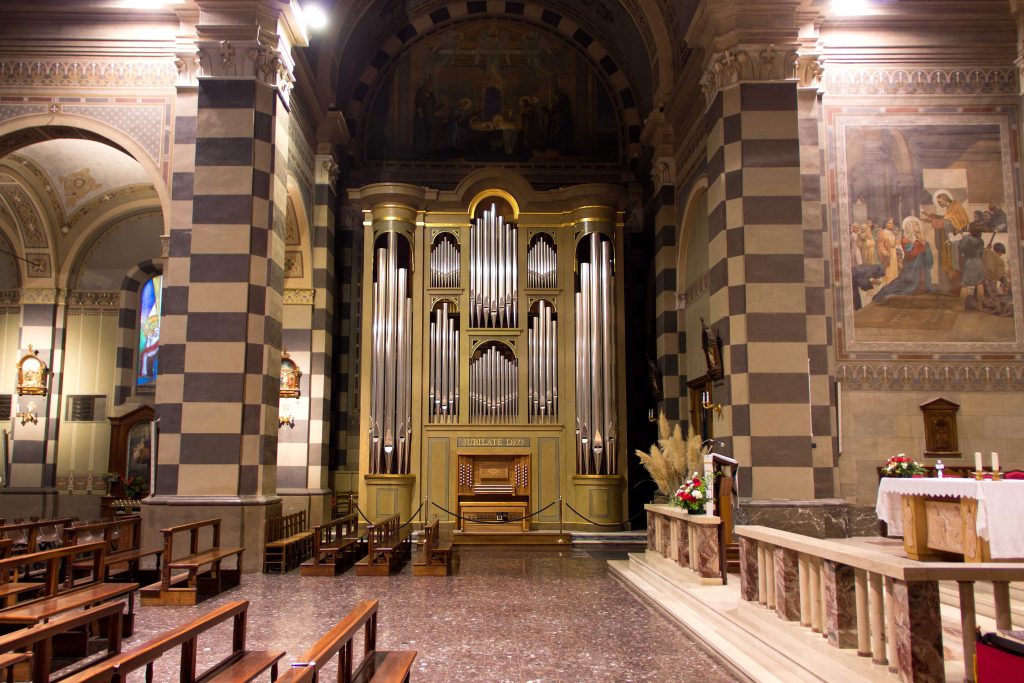
Alessandria is a city in the north-west part of Italy. It is located almost just in between 3 big cities: Milan, Turin and Genoa. The church of San Giovanni Evangelista originally was built in 1905, and was successively restored during the last few years.
Thanks to the efforts of the priest of the church, Don Claudio Moschini, the new organ was built in 2010 by the well known and appreciated company Mascioni. It is a 45 stop 3 manual organ consisting of 5 divisions: Grande Organo, Positivo, Recitativo espressivo, Pedale and Tuba. The tonal composition representing romantic-symphonic style was designed by M°Massimo Nosetti. One of the very interesting features is the Tuba 8′ stop, which is supplied by a separate blower. It’s a high pressure stop running at pressure of 400 mm, which is unique in Italy.
| GRANDE ORGANOPrincipale 16′ Principale 8′ Flauto doppio 8′ Gamba 8′ Ottava 4′ Flauto 4′ Duodecima 2.2/3′ Quintadecima 2′ Ripieno 4/6 file 1.1/3′ Cornetto 5 file 8′ Tromba 16′ Tromba 8′ Tuba 8′ Campane II 8 I III 8 I III 4 I Tremolo |
POSITIVOPrincipale 8′ Flauto a camino 8′ Ottava 4′ Flauto a cuspide 4′ Flauto in XII 2.2/3′ Ottavina 2′ Terza 1.3/5′ Cembalo 2 file 1′ Cromorno 8′ Tuba 8′ III 8 II Tremolo |
RECITATIVO ESPRESSIVOControgamba 16′ Principale 8′ Corno di notte 8′ Salicionale 8′ Voce Celeste 8′ Flauto octaviante 4′ Flautino 2′ Terziana 4 file 5.1/3′ Plein Jeu 3/5 file 2′ Tromba armonica 8′ Oboe 8′ Voix Humaine 8′ Clarone 4′ extension Tuba 8′ Tremolo |
PEDALEContrabasso 16′ Subbasso 16′ Quinta 10.2/3′ Basso 8′ Flauto 8′ Corno 4′ Bombarda 32′ extension Bombarda 16′ Controfagotto 16′ Fagotto 8′ 1 Fagottino 4′ 1 Tuba 8′ I 8 Ped II 8 Ped III 8 Ped III 4 Ped |
|||||||||||||||||||||||||||||||||||||||||||||||||||||||||||||||||||||||||||||||||||||||||||||||
| 1 borrowed from Contrafagotto 16′ Crescendo Annullamento Crescendo disables crescendo pedal Annullamento Ance disables reed stops for crescendo Ance engages all reed stops in the organ |
||||||||||||||||||||||||||||||||||||||||||||||||||||||||||||||||||||||||||||||||||||||||||||||||||

Downloadpreis € 389,-
Chorzów, św. Jadwiga Śląska
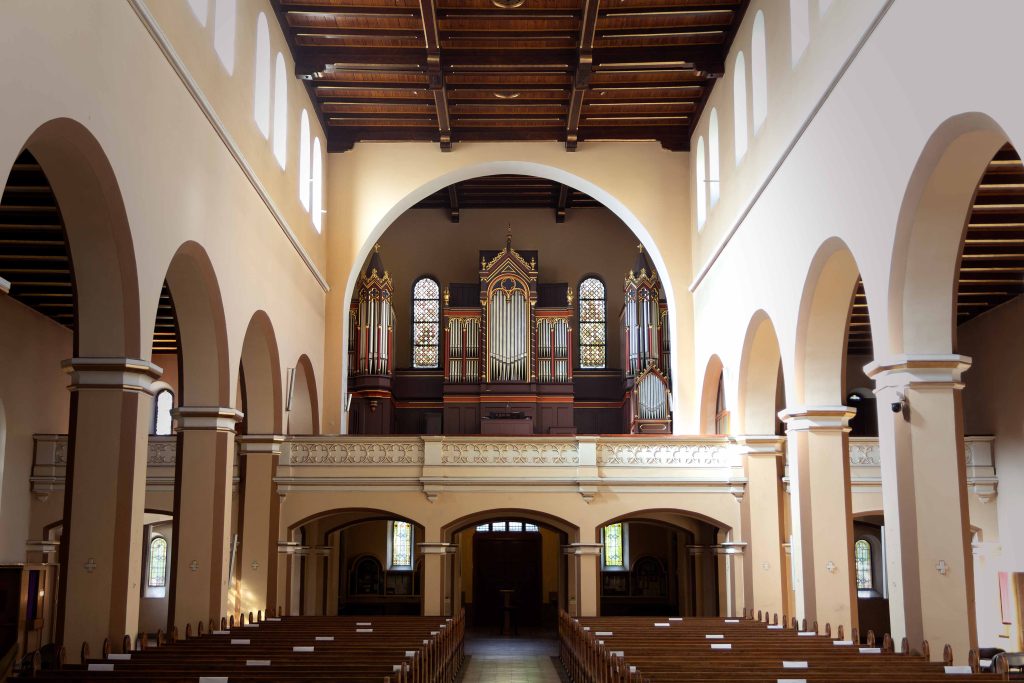
Chorzów Audio Player
is a city in the Upper Silesia region of Poland. It is situated in a metropolitan area which in the past, in the 19th and 20th century, quickly developed thanks to discovery of large coal deposits. Because of that development, many cities were quickly growing. That’s why many churches and pipe organs were built during that time. In those days the most popular style in pipe organs was romantic, symphonic style with tubular-pneumatic action.
The church was built in 1874 in neo-romanesque style. The original organ had tracker action, maybe 2 manuals and around 28 stops. Probably the builder of the first instrument was Adolf Volkmann. It is likely he also built the small 3 stop positiv, which originally was located in a cemetery chapel nearby. It is unknown in which year the organ was relocated to the church’s choir loft. Currently it is unplayable, but there are plans to renovate and move it to its original location. It can be seen on the picture on the right side, below the right tower.
| MANUAL IPrinzipal 16′ Bourdon 16′ Prinzipal 8′ Gamba 8′ Gemshorn 8′ Hohlflöte 8′ Bourdon 8′ Oktave 4′ Gemshorn 4′ Rohrflöte 4′ Fugara 4′ Quint 2 2/3′ Oktave 2′ Mixtur 2 2/3′ 5 fach Kornett 8′ 5 fach Trompete 8′ Manualkoppel II an I Manualkoppel III an I Superoktavkoppel II an I Superoktavkoppel III an I Suboktavkoppel III an I |
MANUAL IIBourdon 16′ Prinzipalflöte 8′ Salicional 8′ Gedeckt 8′ Dolce 8′ Geigenprinzipal 4′ Bachflöte 4′ Flautino 2′ Quintflöte 1 1/3′ Kornettino 2 fach Mixtur 3 fach Klarinette 8′ Tremolo Manualkoppel III an II Superoktavkoppel III an II Suboktavkoppel III an II |
MANUAL III Lieblich Gedeckt 16′ Geigenprinzipal 8′ Flauto amabile 8′ Lieblich Gedeckt 8′ Aeoline 8′ Voix céleste 8′ Violine 4′ Flauto travers 4′ Nasard 2 2/3′ Piccolo 2′ Terzflöte 1 3/5′ Oboe 8′ Tremolo |
PEDALPrinzipalbass 16′ Violon 16′ Subbass 16′ Bourdonbass 16′ 1 Quintbass 10 2/3′ Octavbass 8′ Cello 8′ 1 Bassflöte 8′ 2 extension Octavbass 4′ Posaune 16′ Trompete 8′ Pedalkoppel zum I. M Pedalkoppel zum II. M Pedalkoppel zum III. M |
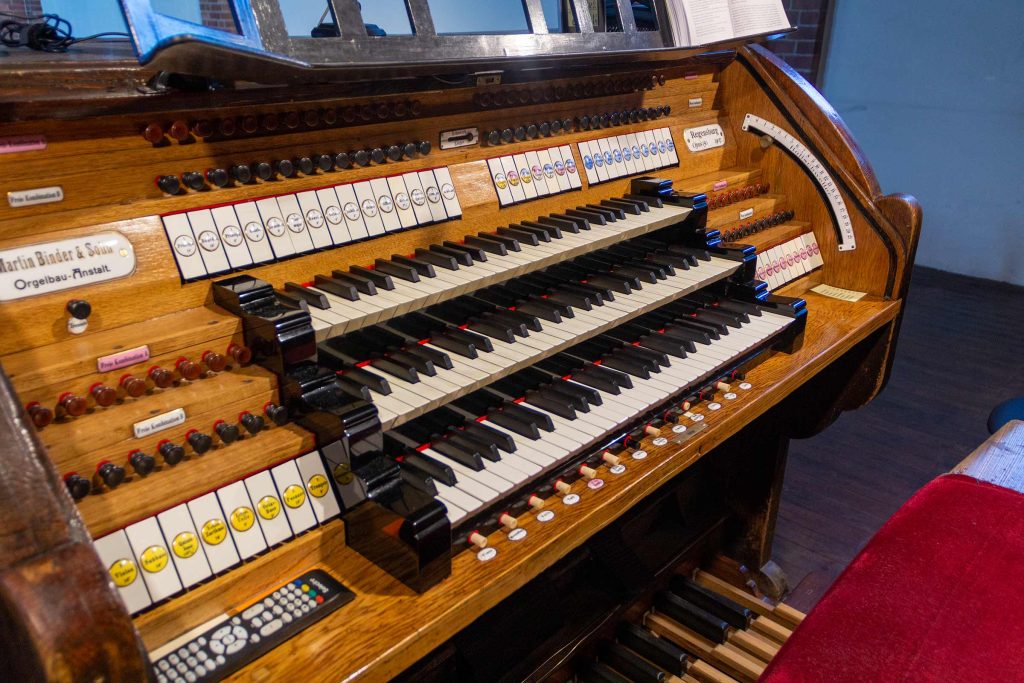
Downloadpreis €350,-
Obervellach, Pfarrkirche St. Martin, Austria
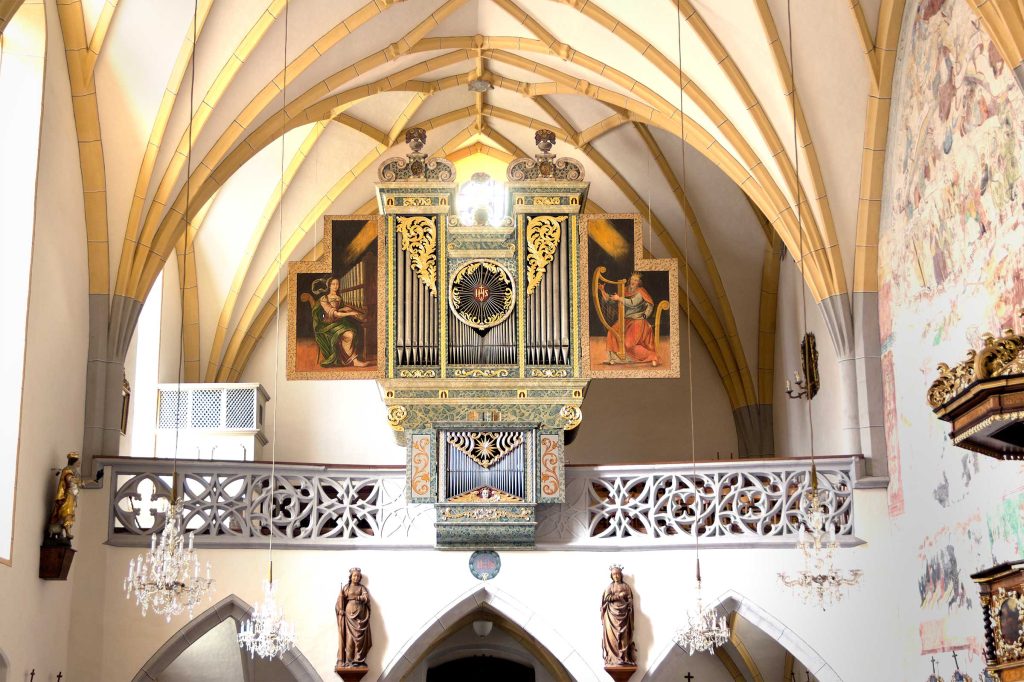
The organ of Obervellach has an interesting and emotional history. Built in 1700 by Franz Köck it is one of the most important historic organs of Carinthia (a region in lower Austria). At the time it was built it was the biggest baroque organ in Carinthia with over 20 stops. Another unique feature for the time was the sun of pipes in the middle of the instrument. Originally these pipes were speaking, possibly forming a special mixture. Holes in the back of the sun verify this presumption. This sun can also be seen as a homage to the organbuilder Eugenio Casparini. Originally the instrument had two manuals and a pedal (both built with a short octave). The original temperament can only be guessed. For the sampleset we have chosen a historic temperament of Barnes, as the instrument nowadays is tuned to equal.
| RÜCKPOSITIVGedeckt 8′ Rohrflöte 4′ Prinzipal 2′ Quint 1 1/3′ Cimbel III 1′ Regal 8′ |
HAUPTWERKQuintatön 16′ Prinzipal 8′ Coppel 8′ Salizet 8′ Octav 4′ Spitzflöte 4′ Quint 2 2/3′ Octav 2′ Quint 1 1/3′ Octav 1′ Mixtur III 1 1/3′ Trompete 8′ POS. – HW. |
PEDALSubbaß 16′ Octavbaß 8′ Gedecktbaß 8′ Choralbaß 4′ Posaune 16′ Trompete 8′ extension POS. – PED. HW. – PED. |
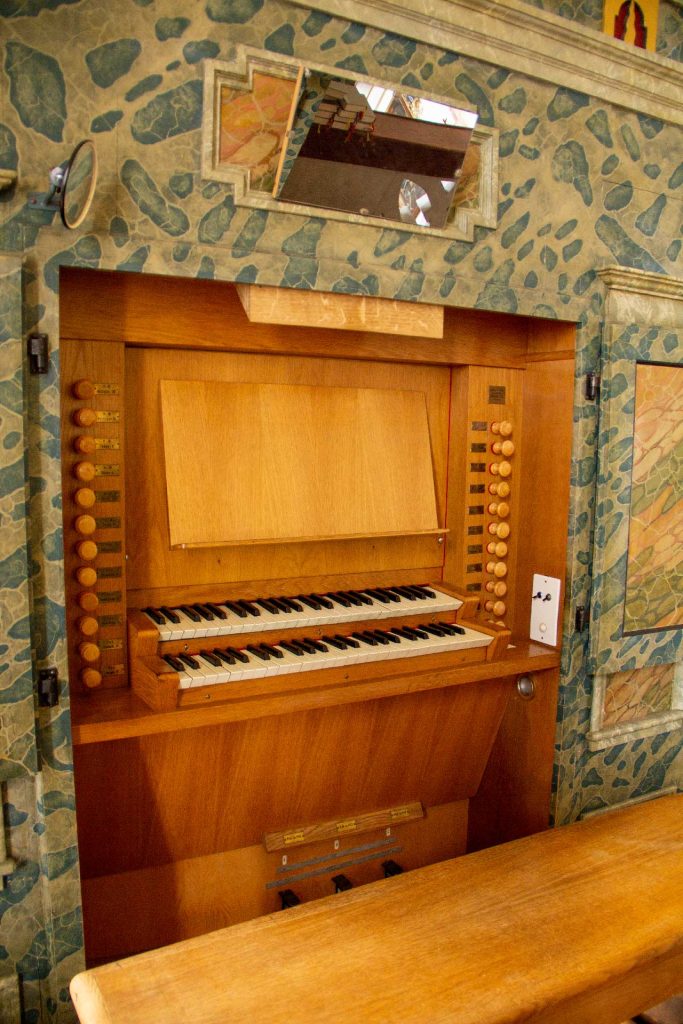
Downloadpreis € 163,-
Erfurt, Büßleben, St. Petri Kirche, Germany
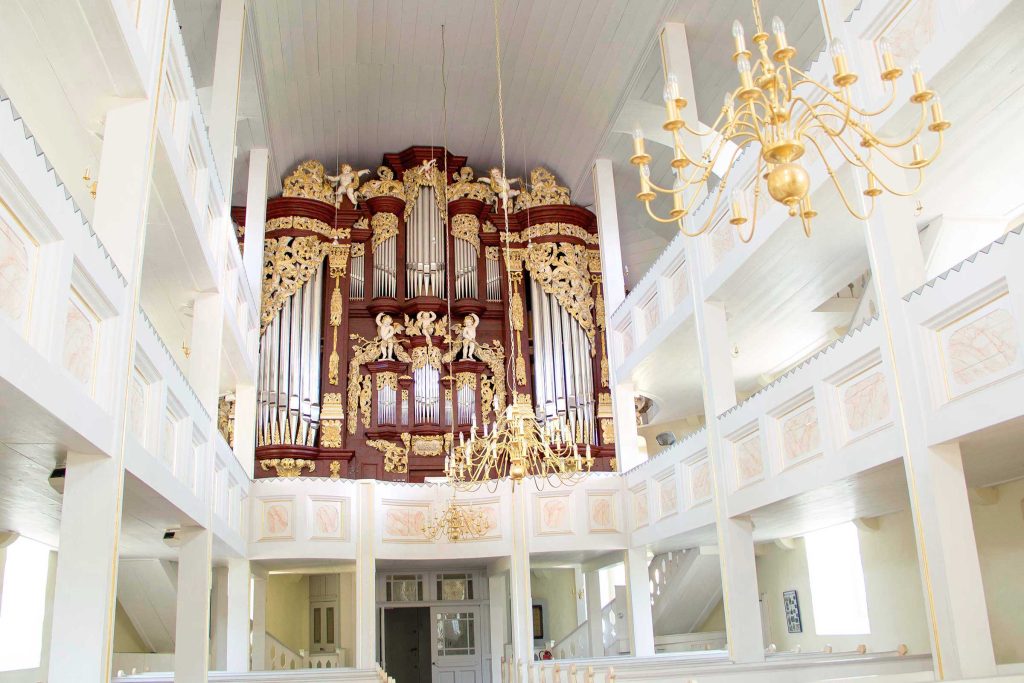
The organ was initially built for the Benedictine monastery located in Erfurt on the Petersberg (Peter’s hill) in 1702. It was made by Georg Christoph Stertzing from Eisenach, who was a very well-known organ builder of his times and was valued by the members of the Bach family. Three members of the family played his instruments!
During the time of secularization, the municipality of Büßleben decided to buy the organ and move it to St. Petrikirche in Büßleben in 1812. At that time, Büßleben was a separate city, and now it is a district of Erfurt. The St. Petri church is the oldest building of Büßleben. Its construction started in 1103. Maybe the reason why the organ survived in the almost unaltered condition is the church, which was far from the big music centres. In the era of romantic modifications, this instrument remained virtually intact, as there was also no place to make such modifications. Even for its original case, it fits the church just right, with no space left above. Despite the changes, which were made throughout its existence, a massive part of the original substance was preserved, which allowed for very accurate renovation, performed by Alexander Schuke company from Potsdam in years 1998-2002.
| OBERWERKQuintaden 16 Fuß Principal 8 Fuß Rohrflöth 8 Fuß Quinta 6 Fuß Octav 4 Fuß Rauschpfeif 2 fach Octav 2 Fuß Sesqaltera 2 fach Mixtur 6 fach Cymbel 3 fach Trombetta 8 Fuß |
BRUSTWERKGedact 8 Fuß Quintaden 8 Fuß Traversa 8 Fuß Principal 4 Fuß Nachthorn 4 Fuß Octav 2 Fuß Waldflöth 2 Fuß Quinta 1 1/2 Fuß Mixtur 3 fach Vox humana 8 Fuß |
PEDALPrincipal 16 Fuß Sub Bass 16 Fuß Violon 16 Fuß Octav 8 Fuß Mixtur 4 fach Posaun 16 Fuß Cornet 2 Fuß Coppel ins Pedal |
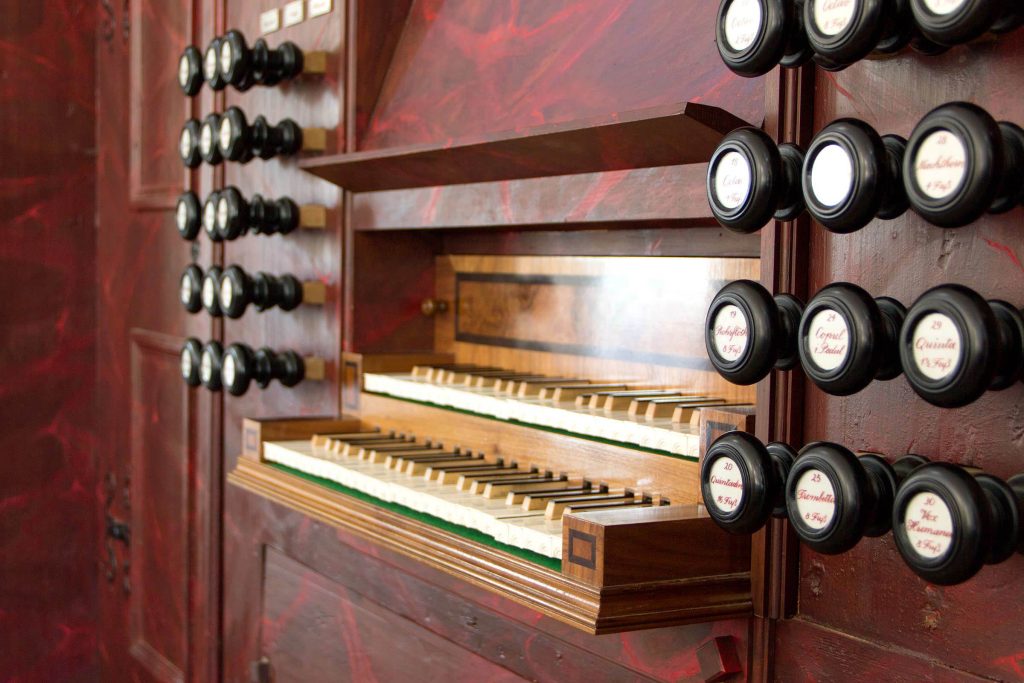
Downloadpreis € 211,-
Oloron-Sainte-Marie, Cathédrale Sainte-Marie, France Aristide Cavaillé-Coll (1870)
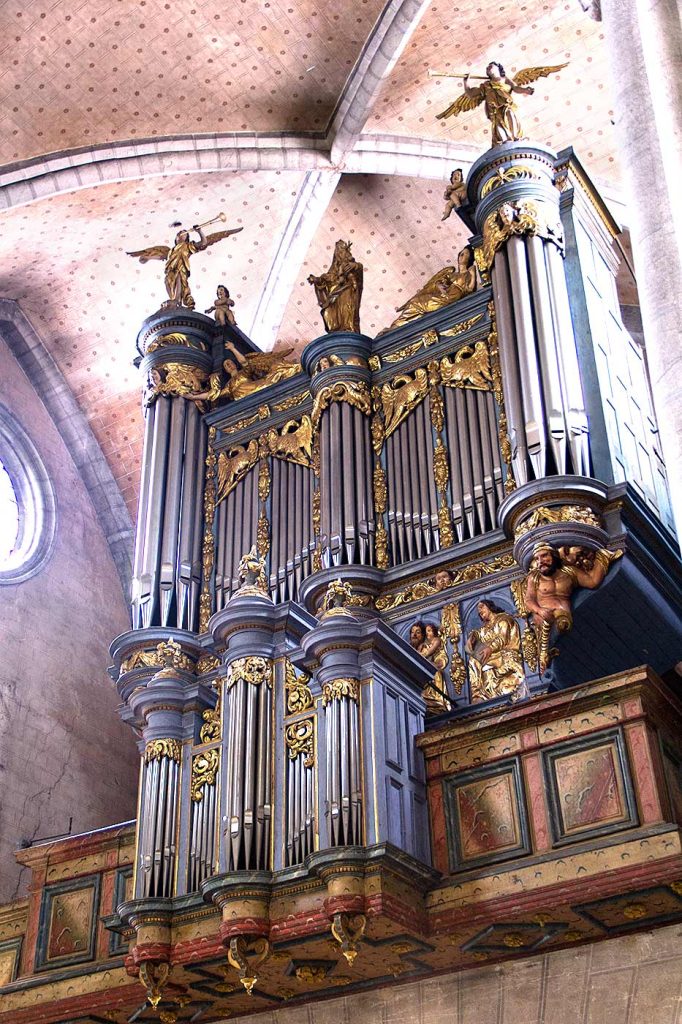
The great organ of Sainte-Marie cathedral in Oloron-Sainte-Marie (France) was built in 1870 by the famous organ builder Aristide Cavaillé-Coll. The original organ dates back to the 17th century. It was most likely built by a member of the Clicquot dynasty. However, during the French revolution of 1789 the organ was emptied of its pipes. Undoubtedly, the pipes were melted down to make ammunition. In 1870, Aristide Cavaillé-Coll built a new organ in the existing place. At the same time, he painted it brown. In 1982 Danion-Gonzalez organbuilding company removed the brown paint to let appear magnificent blue original paint. He also cleaned the instrument.
Today the organ is in the same condition as in 1870 when Cavaillé-Coll finished building it.
| ACCOUPLEURGO / A R / A Octave grave 2 |
GRAND-ORGUEPrincipal 16 Montre 8 Bourdon 8 Viole de gambe 8 Flûte harmonique 8 Prestant 4 Octave 4 1 Doublette 2 1 Plein jeu harmonique V 1 Basson 16 1 Trompette 8 1 Clairon 4 1 |
RÉCIT Flûte traversière 8 Viole de gambe 8 Voix céleste 8 Flûte octaviante 4 Octavin 2 1 Voix humaine 8 Basson et Hautbois 8 1 Trompette 8 1 Trémolo |
PEDALSoubasse 16 Flûte 8 Bombarde 16 1 Trompette 8 1 GO / P R / P |
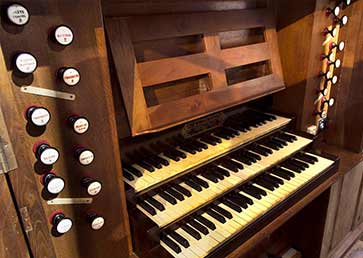
Downloadpreis € 211,-
Metzler Orgel DÜREN
Estimated release: December 2022
| RÜCKPOSITIVPrincipal 8′ Rohrflöte 8′ Octave 4′ Holzflöte 4′ Nasard 2 2/3′ Doublette 2′ Terz 1 3/5′ Larigot 1 1/3′ Scharf IV 1′ Krummhorn 8′ Vox humana 8′ Tremulant SW – RP |
HAUPTWERKPrincipal 16′ Octave 8′ Viola d’Amore 8′ Flûte harmonique 8′ Bourdon 8′ Octave 4′ Spitzflöte 4′ Quinte 2 2/3′ Superoctave 2′ Mixtur V 2′ Cornet V 8′ Fagott 16′ Trompete 8′ Chamade 8′ RP – HW SW – HW |
SCHWELLWERK Bourdon 16′ Gambe 8′ Voix céleste 8′ Doppelflöte 8′ Principal 4′ Traversflöte 4′ Octavin 2′ Sesquialter II 2 2/3′ Mixtur IV 2′ Basson 16′ Trompette harmonique 8′ Oboe 8′ Clarion 4′ Tremulant |
PEDALUntersatz 32′ Holzprincipal 16′ Principalbass 16′ 1 Subbass 16′ 4 Octavbass 8′ Viola 8′ 2 Choralbass 4′ Bombarde 16′ Fagott 16′ 3 Trompete 8′ RP – Ped HW – Ped SW – Ped |
|||||||||||||||||||||||||||||||||||||||||||||||||||||||||||||||||||||||||||||||||||||||||||||||
| 1 borrowed from HW Principal 16′ 2 borrowed from HW Viola d’Amore 8′ 3 borrowed from HW Fagott 16′ 4 extension of P Untersatz 32′ |
||||||||||||||||||||||||||||||||||||||||||||||||||||||||||||||||||||||||||||||||||||||||||||||||||

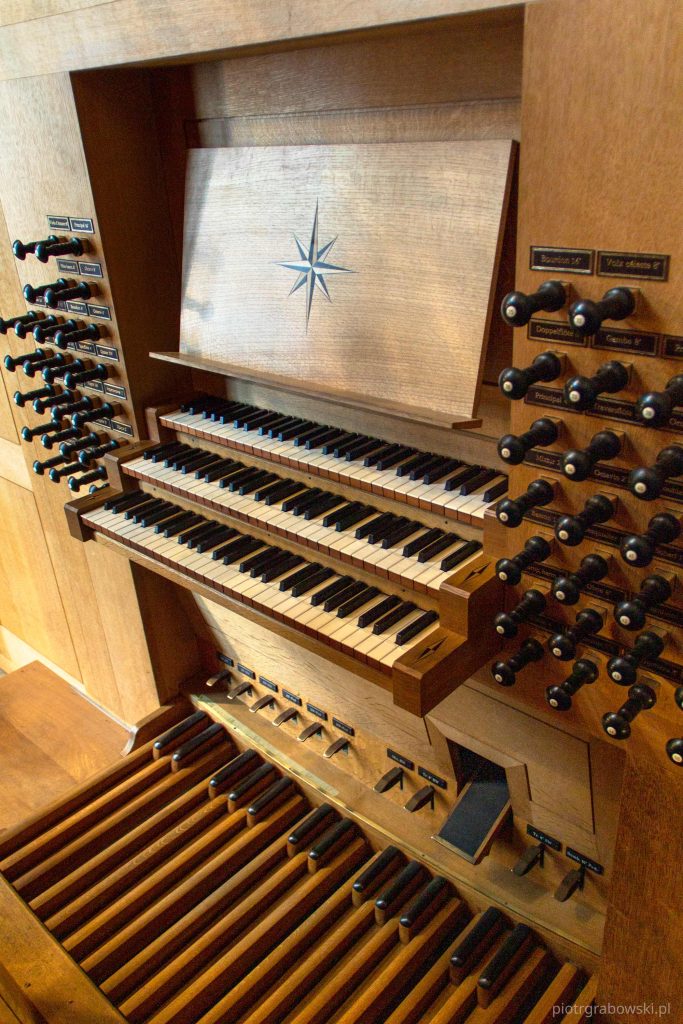
Download Preis € 389;-
Pinerolo Orgelsampleset für Hauptwerk 4.2 +
The organ in Our Lady of Fatima parish church was designed by Carlo Dell’Orto, Massimo Lanzini, and Silvio Sorrentino and built between 2006 and 2011 in the Dell’Orto & Lanzini organ workshop (Arona, Italy) under the direction of Silvio Sorrentino. It is a North German Baroque-style instrument, mainly inspired by the work of Arp Schnitger (1648-1719), the most important and influential organ-builder of the Baroque period in northern Europe. Schnitger integrated the rich tradition of Renaissance and early Baroque organ building, including the structure of spatially separated and tonally independent divisions, into a style characterized by brilliant mixtures and grounding reeds, with excellent fusion capability among different stops, which has been highly influential in 20th-century organ building.
| RückpositivHolfloit 8′ Quintadena 8′ Principal 4′ Rohrfloit 4′ Gemshorn 2′ Scharf III Sesquialtera I-II Dulcian 16′ Trompet 8′ |
HauptwerkQuintadena 16′ Principal 8′ Spitzfloit 8′ Octava 4′ Floit 4′ Nasat 2 2/3′ Octava 2′ Mixtur IV-V Trompet 16′ Vox humana 8′ |
BrustwerkGedackt bass/discant 8′ Holzprincipal discant 8′ Blockfloit 4′ Octava 2′ Quinta 1 1/3′ Regal 8′ |
PedalPrincipal 16′ Octava 8′ Octava 4′ Nachthorn 2′ Mixtur IV Posaun 16′ Trompet 8′ Cornet 4′ |
|||||||||||||||||||||||||||||||||||||||||||||||||||||||||||||||||||||||||||||||||||||||||||||||
| Vogelgesang Cymbelstern Tremulant Download Preis € 236,- |
||||||||||||||||||||||||||||||||||||||||||||||||||||||||||||||||||||||||||||||||||||||||||||||||||

St. Maria Landau - Steinmeyer Orgel 72 Register 3M+Pedal
Landau is a small city in the Rheinland-Pfalz region in south-west Germany, close to the French border. The beautiful church of St. Maria (Saint Mary) was built in 1911 in Neo-Romanesque/Neo-Gothic style.
The organ was built in 1924 by Steinmeyer company from Oettingen in Bayern. It has 72 stops distributed between 3 manuals and pedal. The second and third manuals are enclosed. In the 1950s it was modified, to make it more modern, neo-baroque in sound. Unfortunately, this resulted in heavy modifications of the original concept. Even the casing was removed, to give the organ a more modern look. Thankfully, a restoration endeavour from 2010 to 2012, masterfully undertaken by Romanus Seifert & Sohn from Kevelaer (the same company, which built the organ in Goch), restored the organ to its original state. The meticulous work included the recreation of the console, the restoration of the façade, and the careful renovation of the pipework. From the original 4500 pipes, 3500 were preserved. Missing pipes were recreated using the existing pipework and old documents as reference. Everything was wonderfully voiced, resulting in a harmonious, thoughtful, coherent sound.
Technical details
Download Preis € 546,-

